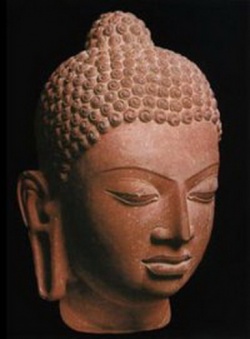Tibetan calendar
The Tibetan calendar (Tibetan: ལོ་ཐོ, Wylie: lo-tho) is a lunisolar calendar, that is, the Tibetan year is composed of either 12 or 13 lunar months, each beginning and ending with a new moon. A thirteenth month is added every two or three years, so that an average Tibetan year is equal to the solar year.
The Tibetan New Year celebration is Losar (Tibetan: ལོ་གསར་, Wylie: lo-gsar). According to almanacs the year starts with the third Hor month. There were many different traditions in Tibet to fix the beginning of the year.
Years
There were different traditions of naming years (Tibetan: ལོ་, Wylie: lo in Tibet. From the 12th century onwards, we observe the usage of two sixty-year cycles. The 60-year cycle is known as the Bṛhaspati (or Vṛhaspati) cycle and was first introduced into Tibet by an Indian Buddhist by the name of Chandra Nath and Chilu Pandit of Tibet in 1025 CE. The first cycle is the rabqung (Tibetan: རབ་བྱུང༌།, Wylie: rab-byung) cycle. The first year of the first rabqung cycle started in 1027. This cycle was adopted from India. The second cycle was derived from China and was called zhugju gor (Tibetan: དྲུག་ཅུ་སྐོར།, Wylie: drug-cu skor). The first year of the first zhugju gor cycle started in 1024. The cycles were counted by ordinal numbers, but the years within the cycles were never counted but referred to by special names. The structure of the zhugju gor was as follows:
Each year is associated with an animal and an element, similar to the Chinese zodiac. Animals have the following order:
Elements have the following order:
Fire Earth Iron Water Wood
Each element is associated with two consecutive years, first in its male aspect, then in its female aspect. For example, a male Earth-Dragon year is followed by a female Earth-Snake year, then by a male Iron-Horse year. The sex may be omitted, as it can be inferred from the animal.
The element-animal designations recur in cycles of 60 years (a Sexagenary cycle), starting with a (male) Wood-Rat year. These large cycles are numbered, the first cycle starting in 1024. Therefore, 2005 roughly corresponds to the (female) Wood-Rooster year of the 17th cycle. The first year of the sixty-year cycle of Indian origin (1027) is called rab-byung (same name as the designation of the cycle) and is equivalent to the (female) fire-Rabbit year.
Year (Gregorian) Year according to rabqung Wylie Element Animal Sex 2008 rabqung 17 lo 22 sa mo glang Earth Rat male 2009 rabqung 17 lo 23 sa pho khyi Earth Ox female 2010 rabqung 17 lo 24 lcags pho stag Iron Tiger male 2011 rabqung 17 lo 25 lcags mo yos Iron Rabbit female 2012 rabqung 17 lo 26 chu pho 'brug Water Dragon male 2013 rabqung 17 lo 27 chu mo sbrul Water Snake female 2014 rabqung 17 lo 28 shing pho rta Wood Horse male 2015 rabqung 17 lo 29 shing mo lug Wood Goat female
Years with cardinal numbers
Three relatively modern notations of cardinal numbers are used for Tibetan years.
On Tibetan banknotes from the first half of the 20th century cardinal numbers can be seen, with year 1 at 225 AD, which is a reference to the 28th king of Tibet, Thothori Nyantsen. A year 1659 means 1659 years have elapsed after the foundation of Tibetan monarchy and gives the year of 1659 + 255 − 1 = 1913. The introduction of this year notation is without doubt related to the proclamation of Tibetan independence by the 13th Dalai Lama in 1912.
Since the second half of the 20th century another year notation has been used, where the year of, for example, 2009 coincides with the Tibetan year of 2136. This relatively modern year notation is referred to as Bot Gyalo (bod rgyal lo). In this era the first year is 127 BC, referring to in this case the first king of Tibet Nyatri Tsenpo.
In Tibetan calendars of the second half of the 20th century and on Tibetan coins cardinal year numbers are found with the indication of rab lo, where the first year coincides with the first year of the rab byung-cycle, that is 1027. Rab lo 928, for example, is the year of 1954 on the western Gregorian calendar.
Months
During the time of the Tibetan Yar-lung Dynasty (7th – 9th century) Tibetan months (zla-ba, ཟླ་བ་ ) were named according to the four seasons:
- First spring month (dpyid-zla ra-ba), middle spring month (dpyid-zla 'bring-po), last spring month (dpyid-zla mtha'-chung),
- first summer month (dbyar-zla-zla ra-ba), middle summer month (dbyar-zla 'bring-po), last summer month (dbyar-zla mtha'-chung),
- first autumn month (ston-zla ra-ba), middle autumn month (ston-zla 'bring-po), last autumn month (ston-zla mtha'-chung),
- first winter month (dgun-zla ra-ba), middle winter month (dgun-zla 'bring-po) and last winter month (dgun-zla mtha'-chung).
From the 12th century onwards each month has been named by the 12 animals of the Chinese zodiac:
- stag (Tiger), yos (Rabbit), 'brug (Dragon), sbrul (Snake), rta (Horse), lug (Goat),
- spre'u (Monkey), bya (Rooster), khyi (Dog), phag (Pig), byi (Rat) and glang (Ox).
With the introduction of the calendar of Kalacakratantra in the second half of the 11th century, months were also named via lunar mansions within which, roughly speaking, a full moon took place each month:
In the second half of the 13th century the famous ruler chos-rgyal 'Phags-pa introduced the system of counting the month by ordinal numbers, the so-called Hor (=Mongolian)-month:
|
|
All these systems of counting or naming months were used up to modern times.
Days
There are three different types of days (zhag), the khyim-zhag, the tshes-zhag and the nyin-zhag.
The first two of these days are astronomical days. The time needed for the mean sun to pass through one of the twelve traditional signs of the zodiac (the twelve khyim) is called khyim-zla (solar month). One-thirtieth of one solar month (khyim-zla) is one khyim-zhag, which might be called a zodiacal day, because there is no equivalent name in Western terminology.
The time needed by the moon to elongate 12 degrees from the sun and every 12 degrees thereafter is one tithi (tshes-zhag, lunar day). The lengths of such lunar days vary considerably due to variations in the movements of the moon and sun.
Thirty lunar days form one lunar or synodic month (tshes-zla), the period from new moon to new moon. This is equal to the time needed for the moon to elongate 360 degrees from the sun (sun to sun). The natural day (nyin-zhag) is defined by Tibetans as the period from dawn to dawn. Strictly speaking, the months appearing in a Tibetan almanac, called by us Tibetan calendar months, are not the same as lunar or synodic months (tshes-zla), which can begin and end at any time of day. In Tibetan, there is no special term for a calendar month containing whole days. These calendar months are just called zla-ba (month).
A Tibetan calendar month normally starts with the week day or natural day (gza' or nyin-zhag) in which the first tithi (tshes-zhag) ends. A Tibetan calendar month normally ends with the week day or natural day (gza' or nyin-zhag) in which the 30th tithi (tshes-zhag) ends. In consequence, a Tibetan calendar month (zla-ba) comprises 29 or 30 natural days. In the sequence of natural days or week days, there are no omitted days or days that occur twice. But since these days are also named by the term tshes together with a cardinal number, it happens that certain numbers or dates (the corresponding tithi) do not occur at all (chad) or appear twice (lhag). The tithi are counted from 1 to 30 and it can happen that a Monday with the lunar day number 1 (tshes gcig) is followed by a Tuesday with the moon day number 3 (tshes gsum). On the other hand, a Monday with the lunar day number 1 (tshes gcig) may be followed by a Tuesday with the lunar day number 1 (tshes gcig). In other words, it happens quite often that certain dates do not appear in the Tibetan almanac and certain dates occur twice. But there are no natural days or week days that occur twice or which are omitted.
The days of the week (gza', གཟའ) are named for celestial bodies.
Day Tibetan (Wylie) Phonetic transcription Object Sunday གཟའ་ཉི་མ་ (gza' nyi ma) Sa nyi-ma Sun Monday གཟའ་ཟླ་བ་ (gza' zla ba) Sa da-wa Moon Tuesday གཟའ་མིག་དམར་ (gza' mig dmar) Sa Mik-mar Mars Wednesday གཟའ་ལྷག་པ་ (gza' lhag pa) Sa Lhak-ba Mercury Thursday གཟའ་ཕུར་བུ། (gza' phur bu) Sa Phur-bu Jupiter Friday གཟའ་པ་སངས་ (gza' pa sangs) Sa Ba-sang Venus Saturday གཟའ་སྤེན་པ་ (gza' spen pa) Sa ben-ba Saturn
Nyima "Sun", Dawa "Moon" and Lhagpa "Mercury" are common personal names for people born on Sunday, Monday or Wednesday respectively.
History
During the time of the Yarlung Dynasty the Tibetan years were named after the 12 animals common for the Chinese zodiac. The month were named according to the four seasons of a year and the year started in summer.
The translation of the Buddhist Kalachakratantra in the second half of the 11th century AD marked the beginning of a complete change for the calendar in Tibet. The first chapter of this book contains among others a description of an Indian astronomical calendar and descriptions of the calculations to determine the length of the five planets and the sun and moon eclipses.
According to the Buddhist tradition, the original teachings of the Kalacakra were taught by Buddha himself. Nevertheless it took more than two hundred years until the Kalacakra calendar was officially introduced as the official Tibetan calendar by the ruler Chos-rgyal 'Phags-pa in the second half of the 13th century. Although this calendar was changed many times during the subsequent centuries, it kept its original character as a luni-solar calendar of Indian origin.






